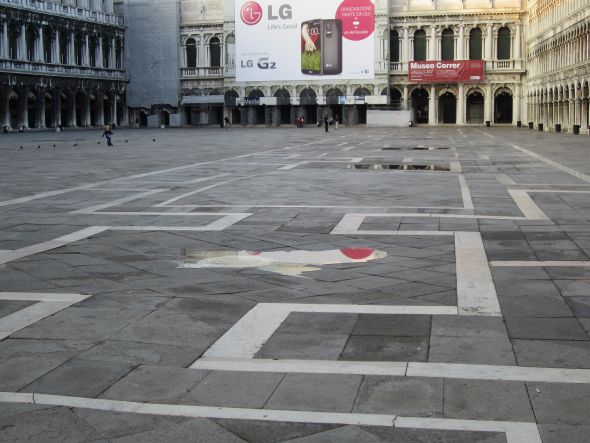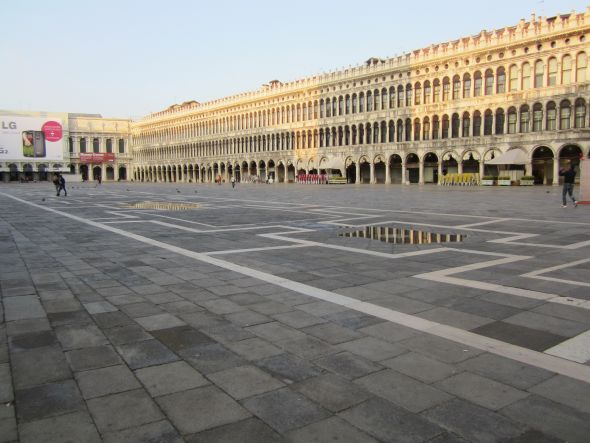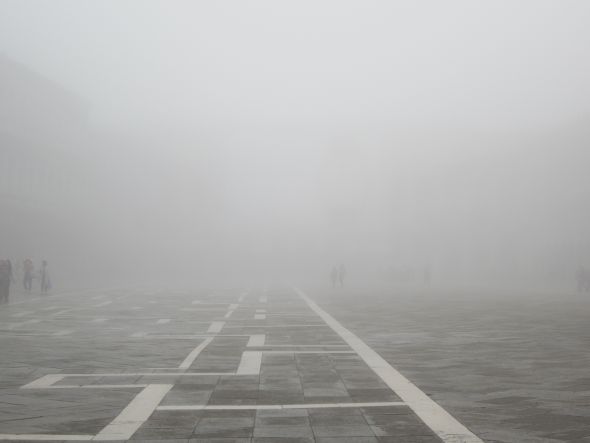
Probably nobody is thinking about New Year’s Eve anymore, no matter where they spent it. But here in Venice it’s not over yet, as the papers continue to publish a cascade of ever-more-detailed articles, personal stories, and editorials on how things went.
In a word: Badly.
So I’m going to back up from my earlier post and try this report again. Because in case you don’t know, the three most beautiful words in the English language are not “I love you” (though they’re not the worst, either).
Nope. The three MOST beautiful words are “You were right.” And in my case, its close cousin: “I was wrong.”
I admit that I felt uneasy writing that sunny little post about New Year’s Eve. Even as I wrote it, I had the strange feeling that I was unaccountably speaking in some unknown language from the planet where life is beautiful all the time.
I must have inadvertently disconnected my internal smoke-detector, because the news is demonstrating, in ever more lurid detail, why I will never go near the Piazza San Marco on the night of Saint Sylvester. And how inexplicably incapable the city is of organizing big events in some reasonable manner. And when I refer to the organization of big events, I have some small experience elsewhere; for example, the Fiesta of San Fermin at Pamplona, which I have attended twice. And I’d go back again, no matter how much I hate crowds, and one of many reasons is because it is organized and maintained in the most dazzlingly intelligent and diligent manner for nine solid days and nights. And a mere twelve hours drives Venice to its knees.
From 9:30 PM, rivers of young people arriving by train filled the streets heading toward the Piazza, smashing bottles and setting off firecrackers as they went.
Far from being a scene of frolic and light-hearted conviviality, as the night dragged on the Piazza San Marco (and Piazzale Roma, whence thousands tried eventually to depart the most beautiful city in the world) resembled a war zone, or a frat party of intercontinental dimensions. Words such as “assault,” “devastation,” and “outrage” highlight the reports of the night, and the morning after.
Piles of shattered glass bottles and pools of biological fluids from either or both ends of homo stupidus prostratus were only some of the abundant remains. There were also the bodies of comatose sleeping revelers scattered around the streets, lying where they fell when the fumes ran out.

The story in figures:
80,000 partyers, 10,000 more than the past two years. Most of the yobbos weren’t Venetian, but from everywhere else — what in New York are called “bridge and tunnel” people. I’ve seen them there at the St. Patrick’s Day parade, and it’s not lovely. It’s no lovelier here.
50 interventions by the 45 emergency medical personnel from the Green Cross, Civil Protection, and SUEM, the ambulance entity; most crises related to alcohol drunk, alcohol spilled (rendering the already wet pavement dangerously slippery), cuts by the broken glass of bottles blindly hurled into the air, blows to the head, and panic attacks caused by the mob and the explosions of firecrackers at close quarters.
100,000 euros ($135,868) the estimated cost to the city, excluding fireworks. This approximate number comprises: 60,000 euros for the collection and removal of 135 cubic meters (4,732 cubic feet)of garbage, of which 20 cubic meters (706 cubic feet) were of glass; 15,000 euros for the 60 Municipal Police agents on security duty. And the cost, not yet quantified, of the extra transport personnel (50 bus drivers and an unspecified number of vaporetto pilots). And the fuel required by the 20 garbage barges.
60 extra buses coming into Venice from the mainland; 123 extra buses between midnight and 7:00 AM from Venice to the mainland. Does this sound like a lot? Au contraire; the ACTV, in its wisdom, put on extra vaporettos, which worked well, but reduced the basic number of bus runs on a holiday eve. Because it’s, you know, a holiday, and the drivers want to be at home. New Year’s Eve in Venice, with reduced bus service. Explain this to the masses of tired, cold, exasperated people who were trying to get back home, who even overwhelmed the relatively few taxis in Piazzale Roma. Explain it to anybody, if you can. And I still can’t figure out how 50 extra bus drivers were sent to work if there were fewer buses. Or were they put to work scrolling the “Out of service” sign onto the buses’ forefronts?
The story in voices:
“It was hard, if not impossible, to move. Funky air, a mix of piss and drugs, the pavement “mined” with bottles, cans, and every sort of garbage…The Piazza was a disaster. Electronic music at full volume incited the crowd that was already drunk and out of control. A great number of young people had taken over, armed with every type of alcohol…the center of the Piazza was an inferno. Not just fireworks, but young people, Italian and foreign, were competing in a new entertainment: the launching of bottles…I didn’t see any security agents that would have forbidden this behavior…The day after, the marks remained on our city, heritage of humanity, devastated by barbarism.” (Margherita Gasco)
“According to a recent international survey, the night between the last and first of the year shows Venice to be among the principal capitals of the festivities on the planet. This shouldn’t prevent us from … reflecting critically on how these events are carried out — if they’re worth the trouble, if they still have their original sense.” (Gianfranco Bettin, the assessore for the Environment).
“Such a high number of people wasn’t predicted, nor predictable,” said Angela Vettese, the assessore of Culture and Tourism Development. (It wasn’t predictable? Does she not read tourism surveys?). “In the future, more prudence is necessary to protect the Piazza, and to invest in more surveillance, so that the police can check, count, and keep access to the Piazza within a determined limit. Furthermore, it’s necessary to organize only high-quality events, with spectacles that involve the public (more involved than they already were?), maintaining greater tranquillity.” She’s still new on the job, or she wouldn’t be talking like that; all these things have been said before, and before, and even before that.

Social network comments were divided between those who think New Year’s Eve in the Piazza is the greatest thing ever, and those who think the care and protection of the already fragile city is more important; those who insist it was just a normal night of festivity, and those who characterize is as another example of sheer lunacy.
“I urge the church to make itself heard, seeing that the civil authorities don’t feel any special need to safeguard the Piazza San Marco…Can we imagine an event like last Tuesday in the Piazza San Pietro in Rome?” (Franco Miracco, art historian).
“San Marco can’t be the only stage for events” (Mons. Antonio Meneguolo, diocese of Venice). “It’s not the number of people which creates bad behavior,” he said. “We can increase the security but it would be better to organize other activities elsewhere, and remove the emphasis of the publicity for “New Year’s in the Piazza,” seeing how the event ends up.”
“Venice continues to be seen as a city to exploit touristically down to the bone,” said Lidia Fersuoch, president of Italia Nostra. “More than limit access to the Piazza, it’s necessary to limited access to the city itself, because it’s impossible to contain more than a certain number of visitors.”
“Certainly, if we take as the limit the Pink Floyd concert of 1989, anything even just barely below that is considered tolerable…But hurling bottles, explosion of firecrackers, people who urinate and vomit in the streets, are these part of the normal course of public socializing? For some people, yes, but for us, no. Especially if it happens in the Piazza San Marco, which isn’t just any piazza, but a monumental area, as it was defined when concerts were stopped (because they have an excessive impact on the Piazza itself)… But why no to concerts, and yes to New Year’s Eve? We speak of “outrage” precisely because it’s a monumental area; you can’t remain indifferent seeing people climbing up the 16th-century columns of the Loggetta of Sansovino at the feet of the campanile. The piazza has always been the place for socializing, for events. But what events?” (Davide Scalzotto)

Here is what I ask myself and anyone who might be listening: There is a Superintendency of architecture, of art, of treasures. There is the Polizia di Stato, the carabinieri, the municipal police, the Guardia di Finanza. There are ordinances forbidding almost every dangerous and tumultuous form of behavior and the hazardous objects associated with them. Why is there no evident point at which any of these elements meet? The behavior and objects are at Point A, and any uniformed persons authorized to intervene are at Points Q, X, and Z. All told, there may have been more garbage collectors than anybody else at work in the Piazza, which seems backwards, to me.
In theory, if there were more agents of public order on duty, there would be less need for the First Aid stations, not to mention the ambulances and garbagemen.
But let me move on to a much more distressing thought.
Venice is a UNESCO World Heritage Site, which, unlike many of the 981 sites on their list, is a real place where real people live and move and have their being. This presents special problems which nobody seems able to anticipate, or resolve. I am at a loss to say why, except that with ten fingers per city councilor, there’s plenty for pointing at other people.
There are 49 UNESCO sites in Italy, more than any other country on earth. So far, none is marked as being “in danger.” I think Venice should be. I cannot conceive of shenanigans such as New Year’s Eve in the Piazza San Marco being tolerated in Angkor, or Machu Picchu, or the Alhambra, or the Red Fort Complex, or the Etruscan Necropolises, or the Potala Palace, or the Galapagos Islands. And this is not the first time. And yet, it goes on.
And I’ll say one more thing, as long as I’m on the subject: Of all the “properties” on UNESCO’s list of World Heritage Sites, only two, so far, have been de-listed. The reasons are given on this page of their website.
Between the catastrophes visited upon Venice under the ever-fresh rubber stamp of the Superintendency of Architectural Treasures (the tormented issue of the maxi-posters in the San Marco area has only been moderately resolved, among other things), and the continued abuse of the lagoon, which is also part of the World Heritage designation (from the Canale dei Petroli to MoSE and now to the imminent approval of the digging of the Contorta canal), I don’t think it’s inconceivable that eventually Venice could see itself de-listed from the UNESCO panoply.
This is not the most improbable scenario I’ve ever come up with. Except that I’d love to be able to say “I was wrong.”
